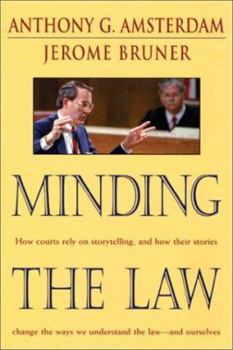Minding the Law
Select Format
Select Condition 
Book Overview
In this remarkable collaboration, one of the nation's leading civil rights lawyers joins forces with one of the world's foremost cultural psychologists to put American constitutional law into an... This description may be from another edition of this product.
Format:Hardcover
Language:English
ISBN:067400289X
ISBN13:9780674002890
Release Date:December 2001
Publisher:Harvard University Press
Length:448 Pages
Weight:1.85 lbs.
Dimensions:1.5" x 6.4" x 9.4"
Related Subjects
Business Business & Finance Business & Investing Courts Criminal Law Education & Reference Judicial System Law Law Enforcement Legal Theory & Systems Philosophy Political Science Politics & Government Politics & Social Sciences Rules & Procedures Social Sciences Textbooks Trial PracticeCustomer Reviews
1 rating
Fascinating Take on Judicial Opinion-writing
Published by Thriftbooks.com User , 14 years ago
Rejecting the usual approach to analyzing case law by first describing the facts, and then reciting the court's decision, Amsterdam and Bruner dig deeper, and describe the hidden decisions which are made when courts (and by inference, lawyers) decide what the "facts" are--and how they are presented. Their hypothesis is that those choices--while virtually never acknowledged, either consciously or unconsciously determine the ultimate decision in a case. One of the examples chosen is a pre-Civil War case holding that states did not have the right to interfere with slave catchers seeking to return escaped slaves to their owners. The case came to the Supreme Court as an appeal from a criminal conviction of a slave catcher for capturing a slave in Pennsylvania without following the procedures established by Pennsylvania. The Court held that the federal Fugitive Slave Law trumped any local laws, and argued that, to hold otherwise, would be to grant states a veto over enforcement of federal law. To reach this seemingly logical conclusion, the Court ordered its presentation of the case around the historic compromise between slave and free states at the Philadelphia Constitutional Convention, and depicted Pennsylvania's procedural rules as an attempt to sabotage this compromise. However, as Amsterdam and Bruner point out, the Court could equally have built its description of the facts (or, to use their paradigm, told its story) from a different perspective. If one looks at the case from the perspective of the purported slave who has been seized, without any opportunity to challenge his "return" to slavery under the laws applicable to every other resident of Pennsylvania, it becomes a case about protecting innocent people from the abuses of slave catchers...or, stated differently, the question is not whether federal law trumps state law, but whether slave catchers have the right to unilaterally declare someone an escaped slave, in violation of established state procedures for making those determinations. Viewed from this alternate story-line, the Court's decision becomes far less obviously right, and certainly more controversial. Amsterdam and Bruner spend much of the book establishing the following building blocks to their argument: (1) people generally organize the way they think about things in narratives...which generally fall into a few well established general patterns ("rise and fall of the tyrant," "conquering hero," "fall from grace," etc.). (2) In telling a story, the teller always makes choices about how to categorize the facts--what to include, what to leave out, when to start, when to stop, and how to present the facts. (3) Judges do exactly the same thing when they write opinions. (4) To understand what judges do, you have to understand the choices they make when they tell their stories (or, more formally, write their opinions). Their argument is highly persuasive. It does, however, become heavy going at times. While Amsterdam is one of t





